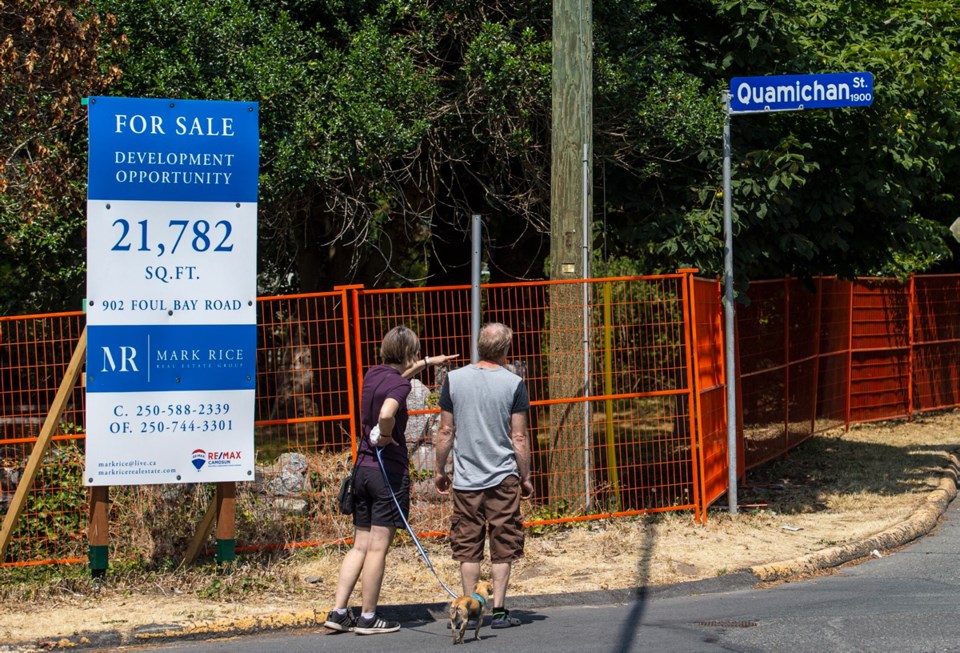A commentary by a neighbour of the proposed project and a middle school teacher in Victoria.
There is a B.C. Housing Affordable Home Ownership Program multi-family housing development proposal in my neighbourhood.
Two 100-year-old trees stand in its way and provide an indirect argument against increased density on a rare large lot. Protest signs are popping up like early daffodils.
Of course, change is not new to the Gonzales neighbourhood. Land in the area had previously been home to the Chilcowitch Songhees, who reportedly sold to the Hudson’s Bay Company.
The name of our community originates not from those inhabitants, who called it home for thousands of years, but from one of the first estates in the neighbourhood, which was called Gonzales by its owner Joseph Despard Pemberton, the first colonial land surveyor.
The Gonzales neighbourhood grew to house wealthy Victorians in their mansions and surrounding estate gardens. The two copper beech trees at 902 Foul Bay Rd. are a vestige of this privileged landscape.
Eventually, street cars and the subdivision of large parcels made the neighbourhood more accessible and diverse.
Following the Second World War, remaining vacant land was developed and most of the colonial estates were further divided. Covenants on many properties, which restricted ownership based on race and sometimes gender, were removed. The neighbourhood adapted to the times and a growing postwar population.
When we moved here, nearly 15 years ago, our street was representative of these changes.
Across from us lived a retired barber, down the street the retired owners of a local restaurant, and next door a navy veteran.
The generations move along, and, sadly, many of those neighbours are now gone. Something has quietly passed with them, a time when people who worked in Victoria could also afford to live here with their families.
The average selling price in our neighbourhood is reported, across several real estate sites, at well over $1 million.
I am grateful for our rising net worth, but I have to wonder who is going to purchase the small, subdivided lot for sale on the street behind us, which is listed at over $800,000.
It is unlikely to be a fellow teacher, nor a nurse, care worker, administrator, technician, or barber. It is also unlikely to be young professionals staying in Victoria to build a family and careers.
Should Victoria’s homes be only for those who had the privilege to purchase decades earlier, or benefit from an inheritance, or for “empty nesters” able to cash in a family home in Toronto or 91ԭ��?
Is everyone else expected to commute in to work? Where do our young families get started? With school catchment boundaries tightened, the financial buy-in to send one’s children to Margaret Jenkins School is now a million-plus. That’s pricey tuition. Our neighbourhood is becoming more privileged again, but not necessarily richer.
Copper beech trees are estate trees, large and beautiful. They need an amount of space that is no longer typical to our urban yards. The two at 902 Foul Bay Rd. fully shade much of the large lot. It is said that they provide habitat, and undoubtedly this is true. I will miss the deer that rest beneath them.
They will be more difficult to rehouse than the animals shown on the protest signs. Yes, “birds need trees,” as do squirrels and raccoons. There should be no doubt of that.
Yet, these two trees are no forest. They are not an ecosystem unto themselves.
In fact, their shade, shallow root systems, and the remnants of lawn around them do not make for particularly good habitat. They are aesthetically pleasing from a distance and I am sure they provide a good perch.
However, if providing habitat is the core concern here, then our urban landscape can do better. Habitat is provided through species diversity and structural complexity.
Planting native trees, shrubs, and grasses around multifamily housing would better achieve the objective, while better suiting the site’s context today.
I truly believe that we can have birds, squirrels and raccoons, while increasing housing options for families.
I highly value the natural environment and I also value community; a community that is accessible to diverse backgrounds and financial standings, a mixture of ages, ideas, and energy.
Our community will continue to change, while our collective choices will determine who is included, and who is excluded. A diversity of housing options is critical to maintaining a healthy, inclusive, and diverse city. If not at 902 Foul Bay Rd., then where?



